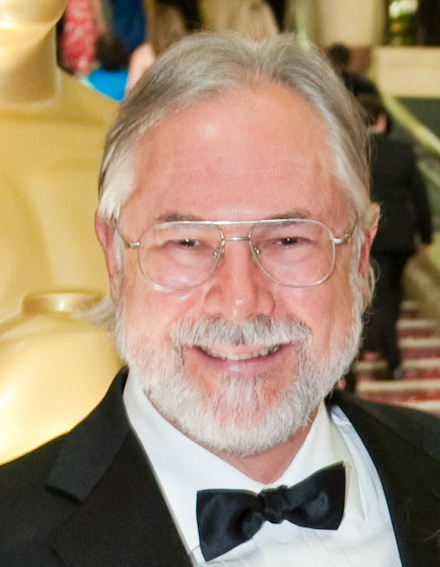
Title
Date
Description
Multiple Available
There are multiple entries on this date. You can modify the date range below to see them all.
Information International Inc. (III, Triple-I)
Established Date: Jan. 1, 1962
Deceased Date: Jan. 1, 1983
- All
- WestWorld
- Information International Inc
- John Whitney Jr
- pixelation
- pioneer
- animation
- software engineer
- artist
- FutureWorld
- Fred Parke
- Ed Catmull
- A Computer Animated Hand
- Faces
- production
- Art Director
-
The company was originally founded to create image processing equipment and digital image scanners. Management (Al Fenaughty and Terry Taugner) brought John Whitney Jr and Gary Demos over from Evans & Sutherland to form a movie group in an attempt to cut their losses after a major failed government contract bid. John Whitney Jr. had been initially introduced to Triple-I because his father (John Sr.) knew Triple-I's founder Ed Fredkin.
-
The F1 was originally built by Triple-I in hopes of getting a large contract with the Government for an Optical Character Recognition system. Its design became the DEC KL-10, but was built on five wire-wrap pages, that were machine wrapped. This meant that it was a one-of-a-kind system, a prototype that never went anywhere. It required a DEC KA-10 (5 tons of stuff that barely could do 1 MIP!), which ran a hacked up version of the TOPS10 operating system, …
The Foonly F1 -
The Motion Picture Project or Entertainment Technology Group was formed at Triple-I in 1975 by Gary Demos, John Whitney Jr., Tom McMahon, Karol Brandt and Art Durinski, later joined by Craig Reynolds and many others.
Founders -
Both Frank Crow and Jim Blinn worked here briefly in 1977 developing algorithms later published in their thesis work. The Actor/Scriptor Animation System (ASAS) was developed by Craig Reynolds, Art Durinski and others; and the modeling tools were written by Larry Malone(Nichiman) using tools such as the Tektronix 4014 storage tube display terminal running Tekshow.
Early software .. and Jim Blinn! -
About this time it was becoming clear to both John Whitney Jr. and Gary Demos that Triple-I was not going to allow the expansion or spin off of the Motion Picture Group as they had originally hoped. John and Gary were instrumental in the pitching and pre-production of the next big CGI film, Tron, but left in April of 1981 before its production to form their own company: Digital Productions.
Digital Productions spin-off -
Other 3D CG tests were done for Star Wars, The Black Hole, and The Empire Strikes Back, but did not end up in the finished films. One particular test for LucasFilm involved Art Durinski building a beautiful 60k poly count X-Wing fighter. Rendered at 4k by 6k resolution, Lucas was only impressed after the ever-amazing Mal MacMillan wrote some additional code to "dirty" it up from it's original pristine CG condition. It was eventually shown on the cover of Computer …
Lucasfilm tests -
Triple-I created the Sark's Carrier, solor sailor and the MCP scenes for the end of the film. Some key people on the work included Art Durinski, Larry Malone, Craig Reynolds, Bill Dungan and Jeremy Swartz.
Tron -
After completing Tron and a 3D (steroscopic) project for Kodak/Epcot called "Magic Journey", Triple-I ceased it's computer graphics business. Some employees joined Digital Production while others joined the new Symbolics Graphics Division.
The End -
 CGM - Episode 02 - FutureWorld
CGM - Episode 02 - FutureWorld -
 CGM - Episode 01 - WestWorld
CGM - Episode 01 - WestWorld -
Most of 1976 was spent producing broadcast logo packages for foreign markets, as the domestic networks were not ready to commit to the new idea of CG flying logos. NBC in particular was one early client Triple-I approached with the idea, only to be rejected in favor of a traditional spinning practical model.
Oversees broadcast work -
1980 saw the production of seven minutes of digital imagery for Looker; another Michael Chrichton film written after the author's visits to Triple-I during Westword and FutureWorld productions. Full body 3D scans where made of an actress from software developed once again my Malcom McMillan. The film was about a company that created computer generated actresses from full body scans ... coincidence!?
Looker -
The first project Whitney Jr. and Demos were charged with was a series of tests for the film Close Encounters of the Third Kind. The concept was for little glowing cubes to fly around during the start of the film's finale. The film's DP Vilmos Zigmund shot some plates with a crane, including some small spheres whose position would be input to a 3D tracking program to extrapolate the matchmove by which to render the 3D elements into the scene. …
Close Encounters tests -
 Demo Reel 1994
Demo Reel 1994 -
 Logo
Logo -
 WestWorld
WestWorld -
 John Whitney Jr.
John Whitney Jr. -
 Craig Reynolds
Craig Reynolds -
 TRON
TRON -
 Tom McMahon
Tom McMahon -
 Larry Cuba
Larry Cuba -
 Gary Demos
Gary Demos -
 FutureWorld
FutureWorld -
 Digital Productions
Digital Productions -
 Richard Taylor
Richard Taylor -
 Looker
Looker
The Foonly F1
The F1 was originally built by Triple-I in hopes of getting a large contract with the Government for an Optical Character Recognition system. Its design became the DEC KL-10, but was built on five wire-wrap pages, that were machine wrapped. This meant that it was a one-of-a-kind system, a prototype that never went anywhere. It required a DEC KA-10 (5 tons of stuff that barely could do 1 MIP!), which ran a hacked up version of the TOPS10 operating system, just to boot it. When it was up, it probably ran at something like 6 MIPS. The Disk systems were old DEC washing-machine style drives that barely held 50Mb, and they crashed at least every month! TRANEW rendering software was written by Gary Demos, Bill Dungan, Rich Schroeppel, Jim Blinn, and a host of others while Triple-I had the machine. Triple-I had married the F1 to a modified PFR-80 film recorder, one of the first in the motion picture industry. Omnibus bought the F1 system because it had produced the majority of the CGI in the film "TRON", and it seemed like a good way to jump-start feature film production. We did scenes from "Explorers", and "Flight of the Navigator" on it, but it was painful.
Founders
The Motion Picture Project or Entertainment Technology Group was formed at Triple-I in 1975 by Gary Demos, John Whitney Jr., Tom McMahon, Karol Brandt and Art Durinski, later joined by Craig Reynolds and many others.
Early software .. and Jim Blinn!
Both Frank Crow and Jim Blinn worked here briefly in 1977 developing algorithms later published in their thesis work. The Actor/Scriptor Animation System (ASAS) was developed by Craig Reynolds, Art Durinski and others; and the modeling tools were written by Larry Malone(Nichiman) using tools such as the Tektronix 4014 storage tube display terminal running Tekshow.
Digital Productions spin-off
About this time it was becoming clear to both John Whitney Jr. and Gary Demos that Triple-I was not going to allow the expansion or spin off of the Motion Picture Group as they had originally hoped. John and Gary were instrumental in the pitching and pre-production of the next big CGI film, Tron, but left in April of 1981 before its production to form their own company: Digital Productions.
Lucasfilm tests
Other 3D CG tests were done for Star Wars, The Black Hole, and The Empire Strikes Back, but did not end up in the finished films. One particular test for LucasFilm involved Art Durinski building a beautiful 60k poly count X-Wing fighter. Rendered at 4k by 6k resolution, Lucas was only impressed after the ever-amazing Mal MacMillan wrote some additional code to "dirty" it up from it's original pristine CG condition. It was eventually shown on the cover of Computer Magazine in 1979. A lower poly count version was created for an animation test Gary Demos did of a five ship formation, complete with anti-aliasing and motion-blur. Unfortunately the seven thousand dollar per minute production cost required by Lucas was much too low for Triple-I to consider real production.Also in 1978 scanning and filmout tests were performed with Richard Edlund at LucasFilm, but the nature of the CRT technology and 5247 film stocks did not yield great results.
Tron
Triple-I created the Sark's Carrier, solor sailor and the MCP scenes for the end of the film. Some key people on the work included Art Durinski, Larry Malone, Craig Reynolds, Bill Dungan and Jeremy Swartz.
The End
After completing Tron and a 3D (steroscopic) project for Kodak/Epcot called "Magic Journey", Triple-I ceased it's computer graphics business. Some employees joined Digital Production while others joined the new Symbolics Graphics Division.
Oversees broadcast work
Most of 1976 was spent producing broadcast logo packages for foreign markets, as the domestic networks were not ready to commit to the new idea of CG flying logos. NBC in particular was one early client Triple-I approached with the idea, only to be rejected in favor of a traditional spinning practical model.
Looker
1980 saw the production of seven minutes of digital imagery for Looker; another Michael Chrichton film written after the author's visits to Triple-I during Westword and FutureWorld productions. Full body 3D scans where made of an actress from software developed once again my Malcom McMillan. The film was about a company that created computer generated actresses from full body scans ... coincidence!?
Close Encounters tests
The first project Whitney Jr. and Demos were charged with was a series of tests for the film Close Encounters of the Third Kind. The concept was for little glowing cubes to fly around during the start of the film's finale. The film's DP Vilmos Zigmund shot some plates with a crane, including some small spheres whose position would be input to a 3D tracking program to extrapolate the matchmove by which to render the 3D elements into the scene. (Malcom McMillan, a UCLA mathematician and key Triple-I programmer wrote this code)
The company was originally founded to create image processing equipment and digital image scanners. Management (Al Fenaughty and Terry Taugner) brought John Whitney Jr and Gary Demos over from Evans & Sutherland to form a movie group in an attempt to cut their losses after a major failed government contract bid. John Whitney Jr. had been initially introduced to Triple-I because his father (John Sr.) knew Triple-I's founder Ed Fredkin.
